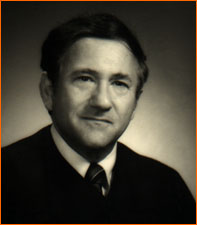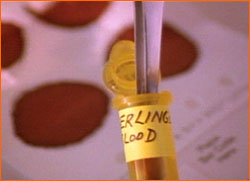
|
 |
 |
The O.J. Simpson trial brought home to millions around the world the degree to which DNA fingerprinting and other laboratory sciences have begun to influence decision-making in the courtroom. In some cases, DNA tests have even led to the release of death-row prisoners whom the tests have exonerated. Here Judge Paul Chernoff of the Norfolk Superior Court in Massachusetts, who organized and attended a recent seminar on DNA given for Massachusetts Superior Court judges at Boston's Whitehead Institute for Biomedical Research, describes the experience and why he feels it is vital that judges be schooled in these novel techniques. NOVA: Have you had to rule on any cases involving DNA analysis such as that performed in the Sheppard murder case? Chernoff: Only in blood and semen matching on a couple of serious sexual assault matters. In one case, it actually ended up exculpating the individual. A woman who was sight-impaired identified her attacker by his voice, and then the DNA testing of his blood versus the semen or sperm found in the woman excluded him absolutely and positively, and he was acquitted. And, you know, that's what Attorney General Janet Reno is concerned about. She thinks the real potential for DNA is to free the innocent, and not to necessarily inculpate the perpetrators, although it certainly works to that effect, too. NOVA: Why is it important that judges be up on DNA analysis in forensics? Chernoff: Well, I think there are at least four reasons why we should be, because the subject can visit us in at least four ways, probably even more. The first way is that, in ruling on admissibility of evidence on a case-by-case basis, this technique comes across our benches now and will continue to do so. It's especially important in criminal cases, because it can exclude or inculpate an alleged perpetrator. The second way is that DNA is such a powerful tool for potentially understanding human behavior, and we're certainly going to see it on that plane. Last week during a case's sentencing, for instance, it was brought to my attention that the defendant had a certain genetic abnormality, which I was asked to consider in the sentencing decision.
The last area is perhaps the most important. It hasn't come to us yet, though we've seen that people in other facets of government, meaning the legislative and executive branches, are often concerned about the potential of this very, very powerful science and whether or not government should regulate it in any way. As the potential for what can be done with this becomes more and more known, I think we judges are going to find ourselves as referees between government and science. NOVA: Should judges have an in-depth understanding of such scientific techniques, or would a basic understanding suffice? Chernoff: I think a basic knowledge would suffice. We in the Superior Court, and I think most judges in courts of general jurisdiction, are generalists, and we're expected to be quick learners, whether the subject matter is science or sports or industry. We should be able to learn it rather quickly. NOVA: So what was it like getting a lesson in DNA analysis? Chernoff: For me, and I think I speak for all of my colleagues, it was really a happening. We had hands-on laboratory experience. In judicial education, we're subjected to a traditionally academic environment, and there's very little chance for hands-on education. Another thing was a little surprising to me. We were forewarned at the beginning that many of us would find it to be an "existential moment" when we completed the laboratory steps and found ourselves face-to-face with actual DNA. And you know, it was. I among others just looked at this gelatinous stuff and said, "My God, that's DNA."
Chernoff: Well, it was both daunting and approachable. Whether or not it made sense, I'll reserve for another day, but the very basics and the overviews certainly made sense to us. We learned that we're trainable, and that with future programs we could come a long way on this. When you think about it, the amount of progress that a group of 25 of us made in just two days under the guidance of a handful of talented young scientists was impressive. I was pretty pleased with how it went, and so was everyone else. We were struck with how young these scientists appear; they were all 25 to 30 years old. NOVA: What do you think is the biggest challenge that science and law will have to face together with DNA? Chernoff: Coping with the specter of an almost infinite amount of information. I don't think we can imagine how much data will be developed and need to be stored and dealt with over time. I don't even know if we've got the mechanism for storing it, and I don't know what the security concerns are, but it's certainly not like having 10,000 fingerprint cards in a file. It's information that will fill up any computer resource and then some. It's going to be more information than we can handle. That's a real problem that science and the courts have to deal with. Also, I'm not sure who should have access to that information. There will be some very disturbing information about a lot of people, which maybe no one should have a right to have. A number of jurisdictions have programs like we have in Massachusetts, in which offenders in certain categories have to give samples for DNA. That information then gets typed and stored. Most jurisdictions don't have the capacity for storing and classifying that information. And that's just the tip of what's going to be a very, very big iceberg. Another interesting thing about the potential of DNA and the potential of storing all of this information is that when people plead guilty now, we tell them that the government has the right to take a sample of their DNA, and that data will then be stored and used for government purposes. It's like a super fingerprint. Continue: If DNA fingerprinting is so seemingly perfect, are you taking the human element out of it? Chronology of a Murder | Science in the Courtroom Create a DNA Fingerprint | 3-D Mug Shot | Cleared by DNA Resources | Transcript | Site Map Editor's Picks | Previous Sites | Join Us/E-mail | TV/Web Schedule About NOVA | Teachers | Site Map | Shop | Jobs | Search | To print PBS Online | NOVA Online | WGBH © | Updated November 2000 |
 Judge Paul Chernoff
Judge Paul Chernoff
 Today, lawyers regularly hire specialists to test
blood from crime scenes, such as this photographed in
the Sheppard home, which brings up privacy issues
unknown in the 1950s.
Today, lawyers regularly hire specialists to test
blood from crime scenes, such as this photographed in
the Sheppard home, which brings up privacy issues
unknown in the 1950s.
 The use of results from DNA studies on the blood of
both victims and attackers alike has become
commonplace in modern courtrooms.
The use of results from DNA studies on the blood of
both victims and attackers alike has become
commonplace in modern courtrooms.